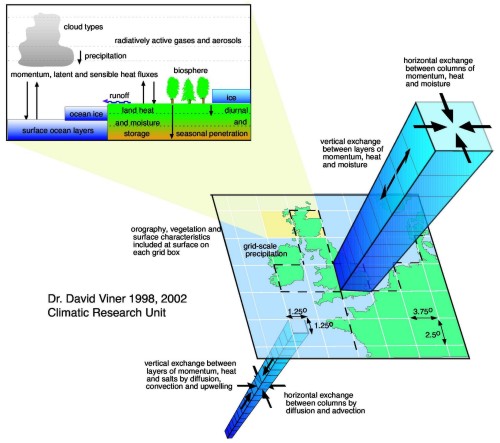What is a GCM?
Numerical models (General Circulation Models or GCMs), representing physical processes in the atmosphere, ocean, cryosphere and land surface, are the most advanced tools currently available for simulating the response of the global climate system to increasing greenhouse gas concentrations (criterion 1 -- see list here). While simpler models have also been used to provide globally- or regionally-averaged estimates of the climate response, only GCMs, possibly in conjunction with nested regional models, have the potential to provide geographically and physically consistent estimates of regional climate change which are required in impact analysis, thus fulfilling criterion 2.
GCMs depict the climate using a three dimensional grid over the globe (see below), typically having a horizontal resolution of between 250 and 600 km, 10 to 20 vertical layers in the atmosphere and sometimes as many as 30 layers in the oceans. Their resolution is thus quite coarse relative to the scale of exposure units in most impact assessments, hence only partially fulfilling criterion 3. Moreover, many physical processes, such as those related to clouds, also occur at smaller scales and cannot be properly modelled. Instead, their known properties must be averaged over the larger scale in a technique known as parameterization. This is one source of uncertainty in GCM-based simulations of future climate. Others relate to the simulation of various feedback mechanisms in models concerning, for example, water vapour and warming, clouds and radiation, ocean circulation and ice and snow albedo. For this reason, GCMs may simulate quite different responses to the same forcing, simply because of the way certain processes and feedbacks are modelled.

|
However, while these differences in response are usually consistent with the climate sensitivity range described in criterion 1, they are unlikely to satisfy criterion 4 concerning the uncertainty range of regional projections. Even the selection of all the available GCM experiments would not guarantee a representative range, due to other uncertainties that GCMs do not fully address, especially the range in estimates of future atmospheric composition.
 "
"
